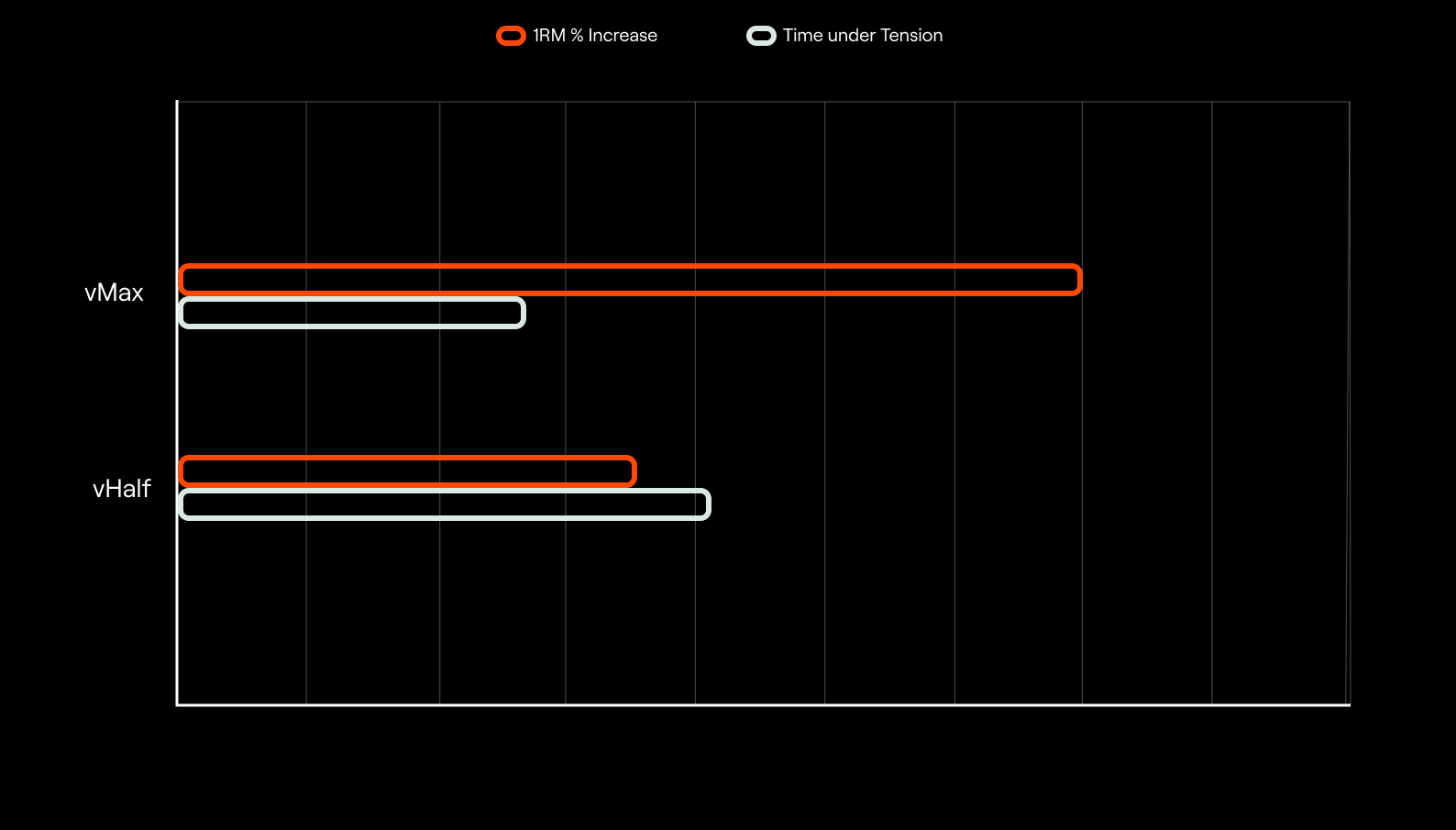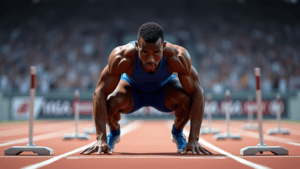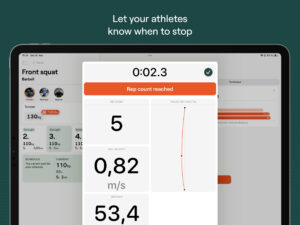Table of content
In the previous article in the series, we dived into the utility of tracking movement velocity during resistance training. That is, the velocity of the concentric muscle action when performing a given exercise with external loads. On a few occasions though, we mentioned something along the lines of “…assuming that you’re giving your best when performing repetitions”. What does it mean to give your “best” when doing resistance training? While we understand that the word “best” can be interpreted in many ways, we feel as though putting maximal effort in all your repetitions is the best way of giving your “best” during resistance training. But what do we mean by maximal effort? In this article, we’ll dive a bit into the maximal effort and see why you should consider it when coaching your athletes or clients.
What does it mean to “lift with maximal intent”?
In simple terms, if we say that an athlete is lifting weights with maximal effort, we usually mean that the athlete is performing the concentric muscle action as fast as possible. For example, in the back squat exercise, concentric muscle action of the prime movers during the squat exercise starts from the bottom position (i.e., peak knee and hip flexion) and finishes at the top position (peak knee and hip extension) of the squat. You might have heard some coaches saying “You should lift with maximal intent” or “She is lifting at maximal intended velocity”. All these expressions are (more or less) synonyms and refer to individuals trying to move the barbell (in the concentric phase) as fast as they can. Now when we defined what the maximal effort or maximal intent refers to during resistance training, let’s see what the research says about its importance.
All other things being equal, lifting with maximal intent leads to greater performance gains
In their study, Gonzalez-Badillo and colleagues [1] looked at the effects of two resistance training programmes equivalent in all training variables except in movement velocity on strength gains in the bench press exercise. The interesting thing about this study is how the researchers manipulated the movement velocity at which participants had to perform a bench press exercise for 6 weeks. The first group performed all repetitions with maximal intent (VMAX group), whereas the other group had to perform their repetitions at half-maximal velocity (VHALF group). Before the training program started, both groups did an incremental loading test in the bench press exercise while performing repetitions at maximal intent. This allowed the researchers to know the velocities at which participants were lifting their submaximal loads. From this point, the VMAX group were training twice a week while lifting with maximal intent whereas the VHALF group was required to intentionally reduce the velocity of the concentric phase of the bench press exercise so that it corresponds to half of what they would normally be able to achieve (i.e., to the half of the velocity they would be able to lift at if they were allowed to).

Bench Press
The researchers used a linear velocity transducer to monitor the velocity of every repetition and used visual and auditory velocity feedback to ensure that participants were providing maximal intent or keeping velocity at half of the theoretically possible velocity at which they could lift for VMAX and VHALF groups, respectively. After 6 weeks of training, while both groups increased their maximal strength, the VMAX group outperformed the VHALF group in strength gains (18.2 vs 9.7%). This is even though the VMAX group experienced less total time under tension (TUT) than the VHALF group (223 vs 361 seconds). Additionally, and perhaps not surprisingly, the VMAX group was also able to lift submaximal loads at greater velocities than the VHALF group during the post-intervention incremental loading test in the bench press exercise. Considering this finding, it is safe to say that the VMAX group outperformed the VHALF group across the entire load-velocity spectrum. What is so fascinating about this study is that the only difference between the groups was in the effort invested, and thus the actual velocity of the movement, into every repetition by the participants.

The same research group [2] later performed a very similar study just with the back squat exercise and found that the VMAX group improved their 1) maximal strength 2) countermovement jump height; 3) velocity against submaximal loads more than the VHALF group. Interestingly, the VMAX group also improved their 10 meter sprint times slightly more than the VHALF group (-2.8 vs – 1.1%), but this difference wasn’t “statistically” significant. As the authors pointed out [2], the improvements of the VMAX group are quite remarkable considering that 1) training consisted of only one exercise (i.e., back squat, without additional jump or sprint training); and 2) only low to moderate number of repetitions were performed and loads used, with exercise sets ending far from muscle failure. As in the previous study, the time under tension in the VMAX group was again lower than in the VMAX group, as expected. It is important to note that this study also looked at the acute metabolic responses to lifting with maximal and half-maximal intent. While the VMAX group experienced slightly greater metabolic stress (more elevated blood lactate and ammonia) than the VHALF group, the post-exercise metabolite levels were low to moderate for both groups, meaning that metabolic factors likely didn’t play a role in the training adaptations described above. Considering this, the discrepancy in the rate of improvement between the VMAX and VHALF groups can be attributed to the distinct movement velocities at which groups were performing their repetitions. Again, the coolest thing about the findings of both studies [1, 2] is that all of this was achieved just by manipulating the amount of effort that participants were investing into the task.

Counter Movement Jump
Why maximal intent works
The results of these two studies [1, 2] demonstrate the importance of both the intent to move as fast as possible (i.e., you should “try your best”) and the actual movement velocity (i.e., it’s also important to “move things fast”, objectively) at stimulating resistance training adaptations. But some of you might ask why that is. Why is it important to “try your best”, even when you can’t “move things fast, objectively” because the load is high? While the neurophysiological mechanisms by which movement velocity influences strength adaptation were not investigated in those studies, training with maximal intent in each repetition could result in a greater and/or more effective recruitment of fast-twitch muscle fibers [3, 4], changes in myosin heavy chain isoform composition [5], increases in tendon-aponeurosis stiffness [6] and increased calcium sensitivity of the contractile apparatus [7]. Regarding the greater improvements of the VMAX than the VHALF group in the jumping ability, the principle of training specificity might apply here. For example, great biomechanical similarities exist between the squat performed with maximal intent and the performance of a jump. For instance, when jumping, the goal is usually to jump as high as you can (or with as little ground contact time, but let’s keep it simple now). To achieve the highest jump height possible, you want to perform the extension of the hips, knees, and ankle joints as fast as possible. Think about it, when you’re instructing your athletes or clients to jump, what do you ask them to do and how does the sequence of movement actions during the jump look like as a result? This is exactly what is occurring during the squat exercise performed with maximal intent which further highlights the importance of not only the actual velocity at which the movement is performed but also the intent with which a given movement is performed.
The hidden benefits of lifting with maximal intent and what’s next.
Ok, it seems that we can achieve greater training adaptations with our athletes or clients by instructing them to perform repetitions with maximal intent. This is fantastic! However, there is another hidden benefit of lifting with maximal intent. In the last article, we mentioned how movement velocity can reflect our feelings about whether something is heavy, just right, or easy on a given day because we would be lifting slow(er), about the same, or fast(er) than we expected that day. However, it is important to note here that your movement velocity will reflect your feelings about what is heavy, just right, or easy better if you’re lifting with maximal intent. Why is that? Well, if you’re not lifting with maximal intent, then movement velocity could also be a reflection of the effort you provided while lifting. For instance, if you were lazy during one set but pushed hard on the second set (with the same load and the number of repetitions), the velocity at which you’d be lifting would be vastly different. However, it would be incorrect to conclude that you were “feeling” differently in those two sets. True, you’d feel different, but that’s only because you were faster in the second set than in the first. That feeling wouldn’t be a reflection of your daily readiness to train and whether something is truly heavier or easier for you that day, but it would simply be a representation of your change in lifting intent. There are other applications of maximal intent that clearly demonstrate its importance, but we will leave them for now until we introduce some other concepts related to the velocity-based approach to resistance training. For now, let’s keep in mind that lifting with maximal intent is the simplest way of squeezing out a couple of extra percentages in performance improvement. In the next article, we will finally start looking into how to use movement velocity to monitor and prescribe resistance training.
References
- González-Badillo, J. J., Rodríguez-Rosell, D., Sánchez-Medina, L., Gorostiaga, E. M., & Pareja-Blanco, F. (2014). Maximal intended velocity training induces greater gains in bench press performance than deliberately slower half-velocity training. European Journal of Sport Science, 14(8), 772-781.
- Pareja-Blanco, F., Rodríguez-Rosell, D., Sánchez-Medina, L., Gorostiaga, E. M., & González-Badillo, J. J. (2014). Effect of movement velocity during resistance training on neuromuscular performance. International Journal of Sports Medicine, 35(11), 916-924.
- Behm, D. G., & Sale, D. G. (1993). Intended rather than actual movement velocity determines velocity-specific training response. Journal of Applied Physiology, 74(1), 359-368.
- Van Cutsem, M., Duchateau, J., & Hainaut, K. (1998). Changes in single motor unit behaviour contribute to the increase in contraction speed after dynamic training in humans. The Journal of Physiology, 513(1), 295-305.
- Aagaard, P., Simonsen, E. B., Andersen, J. L., Magnusson, P., & Dyhre-Poulsen, P. (2002). Increased rate of force development and neural drive of human skeletal muscle following resistance training. Journal of Applied Physiology, 93(4), 1318-1326.
- Bojsen-Moller J, Magnusson SP, Rasmussen LR, Kjaer M, Aagaard P. Muscle performance during maximal isometric and dynamic contractions is influenced by the stiffness of the tendinous structures. Journal of Applied Physiology 2005; 99: 986-994
- Tupling, R., Green, H., Grant, S., Burnett, M., & Ranney, D. (2000). Postcontractile force depression in humans is associated with an impairment in SR Ca2+ pump function. American Journal of Physiology-Regulatory, Integrative and Comparative Physiology, 278(1), R87-R94.




